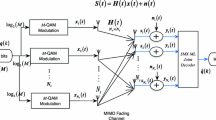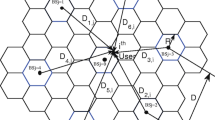Abstract
This paper presents a generalized model of binary phase shift keying (BPSK) direct sequence code division multiple access (DS/CDMA) macrocellular and microcellular sectorized mobile radio systems over Nakagami fading plus lognormal shadowing channels. RAKE receiver, perfect and imperfect sectorization, voice activity monitoring, microscopic and composite microscopic plus macroscopic diversity are considered. The interrelationships among the number of interfering cells, sectorization degree, sectorization imperfection, voice activity factor, fading parameter, microscopic diversity degree, microscopic plus macroscopic diversity degree and the number of users are considered. Numerical results show that voice activity monitoring and sectorization can reduce multiple access interference (MAI). Furthermore, composite microscopic plus macroscopic diversity system can counteract the fast and slow fading components simultaneously.
Similar content being viewed by others
References
R.J.C. Bultitude and G.K. Bedal, “Propagation Characteristics on Microcellular Urban Mobile Radio Channels at 910 MHz”, IEEE Select Area Commun., Vol. 7, No. 1, pp. 31–39, 1989.
P. Harely, “Short Distance Attenuation Measurements at 900 MHz and 1.8 GHz Using Low Antenna Heights for Microcells”, IEEE J. Select. Area Commun., Vol. 7, pp. 5–10, 1989.
J.G. Proakis, Digital Communications third edn, McGraw-Hill: New York, 1995.
R. Price and P.E. Green Jr., “A Communication Technique for Multipath Channels”, Proc. IRE, Vol. 46, pp. 555–570, 1958.
W. Lee Mobile Communication Engineering, McGraw-Hill: New York, 1982.
A. Annamalai, “Microdiversity Reception of Spread-Spectrum Signals on Nakagami Fading Channels”, IEEE Trans. Commun., Vol. 47, No. 11, pp. 1747–1756, 1999.
R. Berhardt, “Macroscopic Diversity in Frequency Reuse Radio Systems”, IEEE J. Select. Areas Commun., Vol. SAC-5, pp. 862–870, 1987.
A.A. Dayya and N.C. Beaulieu, “Analysis of Equal Gain Diversity on Nakagami Fading Channels”, IEEE Trans. Commun., Vol. 39, No. 2, pp. 225–234, 1991.
A.A. Dayya and N.C. Beaulieu, “Outage Probabilities of Cellular Mobile Radio Systems with Multiple Nakagami Interferers”, IEEE Trans. Veh. Technol., Vol. 40, No. 4, pp. 757–768, 1991.
A.M.D. Turkmani, “Performance Evaluation of a Composite Microscopic Plus Macroscopic Diversity System”, IEEE Proceedings I, Vol. 138, No. 1, pp. 15–20, 1991.
A.A. Dayya and N.C. Beaulieu, “Outage Probabilities of Diversity Cellular Systems with Cochannel Interference in Nakagami Fading”, IEEE Trans. Veh. Technol., Vol. 41, No. 4, pp. 343–355, 1992.
Yu Dong Yao and A.U.H. Sheikh, “Investigation into Cochannel Interference in Microcellular Mobile Radio Systems”, IEEE Trans. Veh. Technol., Vol. 41, No. 2, pp. 114–123, 1992.
R. Prasad and A. Kegel, “Effects of Rician Faded and Log-normal Shadowed Signals on Spectrum Efficiency in Microcellular Radio”, IEEE Trans. Veh. Technol., Vol. 42, No. 3, pp. 274–281, 1993.
C.A.F.J. Wijffels, H.S. Misser and R. Prasad, “A Microcellular CDMA over Slow and Fast Rician Fading Radio Channels with Forward Error Correcting Coding and Diversity”, IEEE Trans. Veh. Technol., Vol. 42, No. 4, pp. 570–580, 1993.
A.A. Dayya and N.C. Beaulieu, “Micro-and Macrodiversity NCFSK (DPSK) on Shadowed Nakagami-Fading Channel”, IEEE Trans. Commun., Vol. 42, No. 9, pp. 2693–2702, 1994.
A.A. Dayya and N.C. Beaulieu, “Outage Probabilities in Presence of Correlated Lognormal Interferers”, IEEE Trans. Veh. Technol., Vol. 43, No. 1, pp. 164–173, 1994.
M.G. Jansen and R. Prasad, “Capacity, Throughput and Delay Analysis of a Cellular DS/CDMA System with Imperfect Power Control and Imperfect Sectorization”, IEEE Trans. Veh. Technol., Vol. 44, No. 1, pp. 67–74, 1995.
P.I. Dallas and F.N. Pavlidou, “Macrodiversity Analysis of an M-ary Noncoherent Orthogonal DS/CDMA System on Shadowed Rayleigh Channel”, International Journal of Wireless Information Networks,Vol.3, No. 3, pp. 163–172, 1996.
J. Mar, H.Y. Chen, “Performance Analysis of Cellular CDMA Networks over Frequency Selective Fading Channel”, IEEE Trans. Veh. Technol., Vol. 47, No. 4, pp. 1234–1244, 1998.
J.C. Lin, W.C. Kao, Y.T. Su and T.H. Lee, “Outage and Coverage Considerations for Microcellular Mobile Radio Systems in Shadowed Rician/Shadowed-Nakagami Environment”, IEEE Trans. Veh. Technol., Vol. 48, No. 1, pp. 66–75, 1999.
A. Sathyendran, K.W. Sowerby and M. Shafi, “A Statistical Approach to the Analysis of DS/CDMA Cellular Systems Employing RAKE Receivers and Sectorized Antennas”, IEEE Trans. Veh. Technol., Vol. 48, No. 1, pp. 8–19, 1999.
E.K. Al-Hussaini, I.M. Sayed and E.M. Saad, “Selection and MRC Diversity for a DS/CDMA Cellular System through Nakagami Fading Channel”, Wireless Personal Communications, Vol. 16, No. 2, pp. 115–133, 2001.
K.S. Gilhousen, I.M. Jacobs, R. Padovani, A.J. Viterbi, L.A. Weaver and C.E. Wheatley III, “On the Capacity of a Cellular CDMA System”, IEEE Trans. Veh. Technol., Vol. 40, No. 2, pp. 303–312, 1991.
R. Prasad, CDMA for Wireless Personal Communications, Artech House, Inc.: Boston London, 1996.
M.D. Yacoub, J.E.V. Bautista and L.G. de R. Guedes, “On Higher Order Statistics of the Nakagami-m Distribution”, IEEE Trans. Veh. Technol., Vol. 48, No. 3, pp. 790–794, 1999.
R.L. Pickholtz, L.B. Milstein and D.L. Schilling, “Spread Spectrum for Mobile Communications”, IEEE Trans. Veh. Technol., Vol. 40, No. 2, pp. 313–321, 1991.
L.B. Milstein, T.S. Rappaport and R. Barghouti, “Performance Evaluation for Cellular CDMA”, IEEE J. Select. Areas Commun., Vol. 10, No. 4, pp. 680–689, 1992.
B.R. Vojcic, R.L Pickholtz and L.B. Milstein, “Performance of DS-CDMA with Imperfect Power Control Operating over a Low Earth Orbiting Satellite Link”, IEEE J. Select. Areas Commun., Vol. 12, No. 4, pp. 560–567, 1994.
P. Newson and M.R. Heath, “The Capacity of a Spread Spectrum CDMA System for Cellular Mobile Radio with Consideration of System Imperfections”, IEEE J. Select. Areas Commun., Vol. 12, No. 4, pp. 673–683, 1994.
Author information
Authors and Affiliations
Rights and permissions
About this article
Cite this article
Al-Hussaini, E.K., Al-Bassiouni, A.M., Mourad, H.M. et al. Composite Macroscopic and Microscopic Diversity of Sectorized Macrocellular and Microcellular Mobile Radio Systems Employing RAKE Receiver over Nakagami Fading Plus Lognormal Shadowing Channel. Wireless Personal Communications 21, 309–328 (2002). https://doi.org/10.1023/A:1016076700413
Issue Date:
DOI: https://doi.org/10.1023/A:1016076700413




